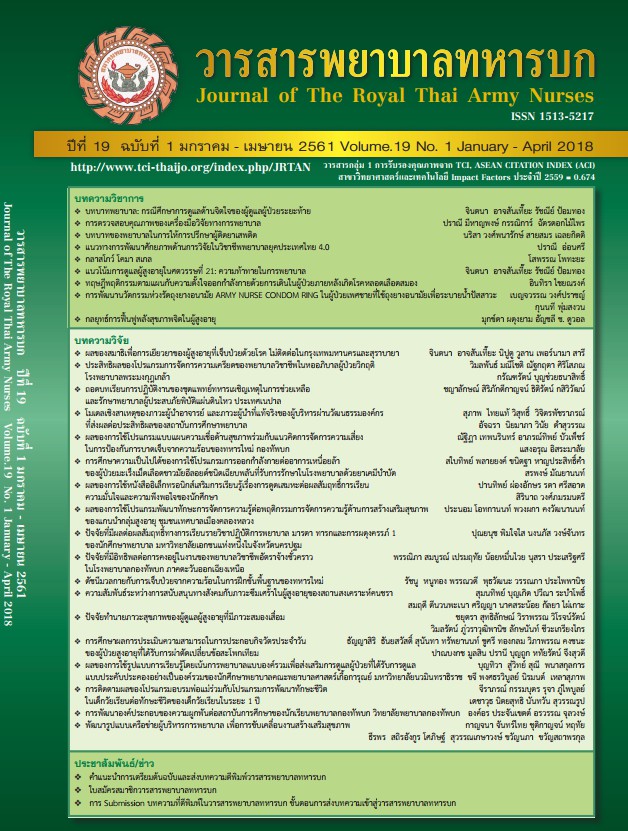การศึกษาความเป็นไปได้ของการใช้โปรแกรมการออกกำลังกาย ต่ออาการเหนื่อยล้าของผู้ป่วยมะเร็งเม็ดเลือดขาวมัยอีลอยด์ชนิดเฉียบพลันที่รับการรักษาในโรงพยาบาลด้วยยาเคมีบำบัด
Abstract
การวิจัยกึ่งทดลองแบบกลุ่มเดียววัดซ้ำครั้งนี้ เพื่อศึกษาความเป็นไปได้ของการใช้โปรแกรมการออกกำลังกายต่ออาการเหนื่อยล้าในผู้ป่วยมะเร็งเม็ดเลือดขาวมัยอีลอยด์ชนิดเฉียบพลันที่ได้รับยาเคมีบำบัด เลือกกลุ่มตัวอย่างแบบสะดวกตามคุณสมบัติที่กำหนดจำนวน 11 ราย โปรแกรมการออกกำลังกายประกอบด้วยการฝึกกล้ามเนื้อร่วมกับการเดิน 15 นาทีเป็นเวลา 4 สัปดาห์ประเมินความเป็นไปได้ของโปรแกรมจากอัตราการเข้าร่วม การคงอยู่ การปฏิบัติตาม และความปลอดภัย อาการเหนื่อยล้าประเมินจากแบบประเมินอาการเหนื่อยล้าของไปเปอร์ผลการวิจัยพบว่า โปรแกรมการออกกำลังกายมีความเป็นไปได้ในการนำไปใช้ โดยมีอัตราการเข้าร่วม ร้อยละ 100 อัตราการคงอยู่ร้อยละ 91.67 อัตราการปฏิบัติตามโปรแกรมร้อยละ 100 มีความปลอดภัยสูง และมีความพึงพอใจโปรแกรมในระดับมากถึงมากที่สุด เมื่อเปรียบเทียบอาการเหนื่อยล้าหลังการเข้าร่วมโปรแกรม 4 สัปดาห์ กลุ่มตัวอย่างมีคะแนนเฉลี่ยอาการเหนื่อยล้าสัปดาห์ที่ 2 และ 3 แตกต่างจากสัปดาห์ที่ 4 อย่างมีนัยสำคัญทางสถิติ และระยะทางการเดินเฉลี่ย 15 นาทีสัปดาห์ที่ 2 แตกต่างจากสัปดาห์ที่ 4 มีค่ามัธยฐานของระยะทางการเดินเฉลี่ยสัปดาห์ที่ 2 แตกต่างจากสัปดาห์ที่ 4 อย่างมีนัยสำคัญทางสถิติ ผลจากการวิจัยเสนอแนะว่า ผู้ป่วยมะเร็งเม็ดเลือดขาวที่ได้รับยาเคมีบำบัดสามารถออกกำลังกายด้วยการฝึกกล้ามเนื้อร่วมกับการเดิน 15 นาทีได้อย่างปลอดภัย และการออกกำลังกายอย่างต่อเนื่อง 4 สัปดาห์ช่วยเพิ่มความทนและอาจช่วยลดอาการเหนื่อยล้าได้
A Feasibility Study Of An Exercise Program On Fatigue Of Hospitalized Patients With Acute Myeloid Leukemia Undergoing Chemotherapy
This quasi-experimental research design with a one-group repeated measure was to examine the feasibility of an exercise program on fatigue in acute myeloid leukemia patients undergoing chemotherapy. The 11 subjects were selected by convenience follow to inclusion criterias. The exercise program combined with strength training and a 15-minute walk for 4 weeks. The feasibility of an exercise program was tested including recruitment, retention, adherence and safety. Fatigue was using Piper’s Fatigue Scale. The findings revealed that the exercise program was a feasibility program with a participation rate of 100%, a retention rate of 91.67%, and an adherence rate of 100%. The program was safe and acceptable with the high to highest satisfaction level. Post-test fatigue comparison after participation in the program found
statistical significant differences. Mean of fatigue scores at 2nd week and 3rd week were statistically significant different from 4th week. Furthermore, the mean of 15-minute walk distance was found to be statistically significant different from 4th week. The median mean walking distance at 2nd week was statistically significant different from 4th week. The results of this study recommended that the implementation of the exercise program is safe for patients with acute myeloid leukemia undergoing chemotherapy. The continuity of exercise for four weeks can increase physical endurance and may reduce fatigue.
Downloads
Downloads
Published
How to Cite
Issue
Section
License
บทความหรือข้อคิดเห็นใดใดที่ปรากฏในวารสารพยาบาลทหารบกเป็นวรรณกรรมของผู้เขียน ซึ่งบรรณาธิการหรือสมาคมพยาบาลทหารบก ไม่จำเป็นต้องเห็นด้วย
บทความที่ได้รับการตีพิมพ์เป็นลิขสิทธิ์ของวารสารพยาบาลทหารบก
The ideas and opinions expressed in the Journal of The Royal Thai Army Nurses are those of the authors and not necessarily those
of the editor or Royal Thai Army Nurses Association.






